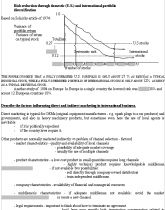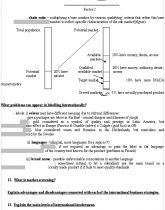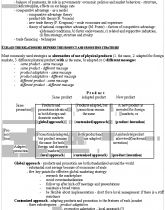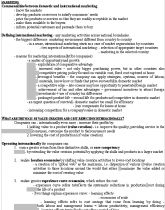Hledej
Zobraz:
Univerzity
Kategorie
Rozšířené vyhledávání
12 662
projektů
International marketing - otázky
| Přípona .doc |
Typ vypracované otázky |
Stažené 1 x |
| Velikost 0,2 MB |
Jazyk český |
ID projektu 2480 |
| Poslední úprava 06.12.2013 |
Zobrazeno 1 297 x |
Autor: eliskabila |
 Sdílej na Facebooku
Sdílej na Facebooku |
||
| Detaily projektu | ||
- Cena:
4 Kreditů - kvalita:
82,0% -
Stáhni
- Přidej na srovnání
- Univerzita:Masarykova univerzita
- Fakulta:Ekonomicko-správní fakulta
- Kategorie:Ekonomika » Management
- Předmět:Mezinárodní management a marketing
- Studijní obor:-
- Ročník:-
- Formát:MS Office Word (.doc)
- Rozsah A4:28 stran
1. Explain commonalities and specifics of international marketing in relation to domestic marketing.
Commonalities between domestic and international marketing
- know the markets
- develop products or services to satisfy consumers´ needs
- price the products or services so that they are readily acceptable in the market
- make them available to the buyers
- inform potential customers and persuade them to buy
Defining international marketing - any marketing activities across national boundaries.
- the biggest difference: marketing environment different from country to country
- in a sense, international marketing starts as a case of market segmentation by countries
- two aspects of international marketing: - selection of appropriate target countries
- marketing in the selected country
- reasons for marketing internationally(for companies):
- a matter of opportunity and growth
- exploitation of comparative advantage
- increased sales – not only bigger purchasing power, but in other countries also competitive pricing policy focused on variable cost, fixed cost captured at home
- leveraged benefits – the company can apply strategies, systems, sources of labour, materials, know-how or funds that prove successful in domestic market
- a competitive edge – late-comers may lose opportunity to penetrate foreign market
- achievement of tax and other advantages – government incentives to attract foreign investments + use of country tax differences
- prolonged product life – second life for products not competitive in domestic market
- an urgent question of survival - domestic market too small for efficiency
- can compensate for losses at home
- increasing competition for a company's sales in domestic market
What are the ways of value creation and cost reduction internationally?
Companies can - internationally even more - increase their profits by:
1. adding value to a product (value creation) - i.e. improve the quality, providing service to the consumer, customise the product to the consumer's needs
2. lowering the cost of production (of value creation)
Operating internationally the companies can:
1. earn a greater return from their distinctive skills, or core competency
- by extending the value creation potential by applying the skills and products in a larger market
2. realise location economies by shifting value creation activities to lower-cost locations
- a creation of a "global web" as the maximum, i.e. dispersion of various value creation activities to those locations around the world that either maximise the value added or minimise the cost of creating value
3. realise greater experience curve economies, which reduce the cost
- experience curve refers to/reflects the systematic reductions in production cost during the life of a product
- two things explain experience curve: - learning effects
- economies of scale
- learning effects refer to cost savings that come from learning by doing - both labour and management learns = labour productivity, management efficiency - learning effects typically die out after a period of time
- scale economies - reductions in unit cost by producing a large volume
- basis: ability to spread fixed costs over a large volume
- not only machinery, premises, etc. - also RD
Commonalities between domestic and international marketing
- know the markets
- develop products or services to satisfy consumers´ needs
- price the products or services so that they are readily acceptable in the market
- make them available to the buyers
- inform potential customers and persuade them to buy
Defining international marketing - any marketing activities across national boundaries.
- the biggest difference: marketing environment different from country to country
- in a sense, international marketing starts as a case of market segmentation by countries
- two aspects of international marketing: - selection of appropriate target countries
- marketing in the selected country
- reasons for marketing internationally(for companies):
- a matter of opportunity and growth
- exploitation of comparative advantage
- increased sales – not only bigger purchasing power, but in other countries also competitive pricing policy focused on variable cost, fixed cost captured at home
- leveraged benefits – the company can apply strategies, systems, sources of labour, materials, know-how or funds that prove successful in domestic market
- a competitive edge – late-comers may lose opportunity to penetrate foreign market
- achievement of tax and other advantages – government incentives to attract foreign investments + use of country tax differences
- prolonged product life – second life for products not competitive in domestic market
- an urgent question of survival - domestic market too small for efficiency
- can compensate for losses at home
- increasing competition for a company's sales in domestic market
What are the ways of value creation and cost reduction internationally?
Companies can - internationally even more - increase their profits by:
1. adding value to a product (value creation) - i.e. improve the quality, providing service to the consumer, customise the product to the consumer's needs
2. lowering the cost of production (of value creation)
Operating internationally the companies can:
1. earn a greater return from their distinctive skills, or core competency
- by extending the value creation potential by applying the skills and products in a larger market
2. realise location economies by shifting value creation activities to lower-cost locations
- a creation of a "global web" as the maximum, i.e. dispersion of various value creation activities to those locations around the world that either maximise the value added or minimise the cost of creating value
3. realise greater experience curve economies, which reduce the cost
- experience curve refers to/reflects the systematic reductions in production cost during the life of a product
- two things explain experience curve: - learning effects
- economies of scale
- learning effects refer to cost savings that come from learning by doing - both labour and management learns = labour productivity, management efficiency - learning effects typically die out after a period of time
- scale economies - reductions in unit cost by producing a large volume
- basis: ability to spread fixed costs over a large volume
- not only machinery, premises, etc. - also RD
Klíčová slova:
cost reduction
labelling
market screening
global money management
globalisation
Obsah:
- 1. Explain commonalities and specifics of international marketing in relation to domestic marketing. What are the ways of value creation and cost reduction internationally?
2. Which are the main elements of international trade and finance related to international marketing? Explain the relationship between the product and promotion strategies.
3. Explain the role of economic environment in international marketing. Explain the different international sensitivity of products as to their types.
4. Explain the role of socio-cultural environment in international marketing. Explain the main factors influencing international promotional mix.
5. Explain the role of political environment in international marketing. What is a transfer price, and its role in marketing?
6. Explain the role of legal environment in international marketing. Which organisational structures prevail in different types of multinational companies?
7. Explain the role of competitive environment in international marketing. (What is the difference between the comparative advantage and competitive advantage?) Characterise the main features of international marketing as applied to the Czech Republic.
8. Explain the role of the main levels of international business involvement in international marketing. How can the difference between total and physical product be used in international marketing?
9. Explain the main strategies in international marketing. What are the main constraints of international standardisation of distribution channels?
10. What are the specific features of international marketing in the CR? Explain the main factors influencing pricing strategies in international marketing.
11. Explain the main methods of market size measurement in international marketing. What problems can appear in labelling internationally.
12. What is market screening? Explain advantages and disadvantages connected with each of the international business strategies.
13. Explain the main levels of international involvement. Explain the connection between different control systems and international business strategies.
14. What does the market screening on the basis of competitive forces concentrate on? Explain the specifics of interaction of pricing in international business with other elements of marketing mix.
15. What are advantages and disadvantages of exporting compared to other levels of international involvement? Explain four types of strategies of international business.
16. What are advantages and disadvantages of licensing compared to other levels of international involvement? Discuss the issues of international distribution strategies.
17. What are advantages and disadvantages of joint venture compared to other levels of international involvement? Explain main objectives of global money management.
18. What are advantages and disadvantages of direct investment compared to other levels of international involvement? What are the main effects of cost pressures arising from international competition on corporate strategies in international business?
19. What are strategic alliances as a form of international involvement? Explain the problem of FX risk in international business.
20. What are the main factors of a successful alliance? Explain the problem of performance ambiguity in international marketing.
21. How can the multinational companies manage FX risk? Which are the main elements to be assessed in international market analysis?
22. Explain the specific balances in the balance of payments account, and their meaning for international marketing. Explain the main accounting problems and possible benefits for multilateral companies.
23. Explain financial decisions related to international economic involvement. Describe the factors influencing direct and indirect marketing in international business.
24. Explain main techniques of moving money internationally. What role can social impacts of globalisation have in international marketing?



